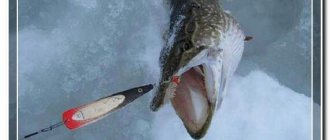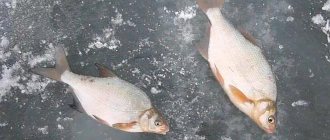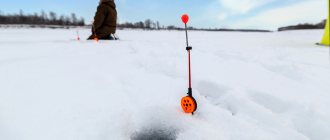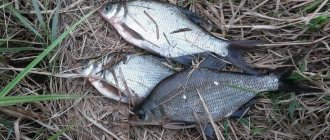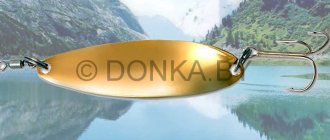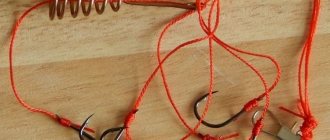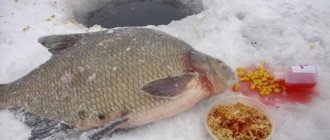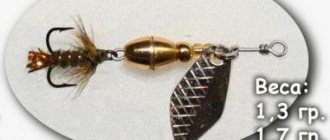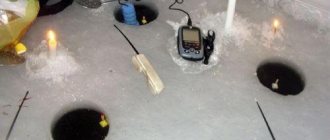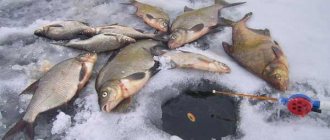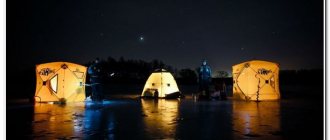Fishing for bream on the current in winter is no less exciting and productive than on the more familiar bream reservoirs and lakes. In conditions of constant water flow, this fish is caught more actively not only on the last and first ice, but even in the dead of winter. As with reservoirs with stagnant water, the fundamental success when fishing is the correct choice of location, gear, bait and mandatory feeding.
Suitable places for catching bream on the river in winter
For river bream fishing in winter, choose places with a small or medium current, great depth (at least 4-5 meters) and a hard clay bottom with a small layer of silt.
The most catchy places on the river are:
- The upper edge of the channel ditch within a quiet and wide reach;
- Coastal ditches and their dumps located under steep banks (jams);
- A deep-sea snag submerged in the middle of the river;
- Potholes near the confluence of tributaries (smaller rivers, streams, ditches) into the river.
- Small and deep backwaters, not silted and not overgrown oxbow lakes with depths of at least 5 meters.
You can also often find bream and bream in the watering areas bordering deep holes and ditches. Most often, fish come to such places during the last ice or during long thaws.
Important! Bream does not hold in places with a hard pebble bottom and too fast a current.
Just like in the summer, this fish visits dumps inhabited by the river zebra mussel. Similar areas should be marked during summer feeder fishing.
Baits and lures
- Bloodworms and/or maggots.
- Larva of meal and burdock moth.
- Crawling out.
- Worm.
- Pearl barley, pea dough.
Expert opinion
Knipovich Nikolai Mikhailovich
Zoologist, hydrobiologist. I am interested in fishing at a professional level.
Do not try to use plant baits for winter fishing. During cold weather, bream prefers animal food.
Bloodworms are usually baited one at a time or in a bunch; to catch large bream, they are used together with maggots. You can add protein to the dough; this bait works best in February-March.
Features of winter fishing on the current
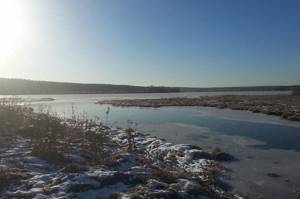
In winter fishing for bream on a river, compared to still water, there are a number of the following features:
- Use of heavy weights in rigs - the presence of a constant flow of water requires the use of sinkers weighing from 2-3 to 8-10 or more grams in bream rigs;
- Use of thicker and stronger monofilament. When landing fish, the current creates additional resistance. Monofilament with a cross-section from 0.12-0.14 mm to 0.2-0.22 mm is used as the main fishing line;
- Feeding exclusively “to the bottom” - unlike reservoirs with stagnant water on the river, a feeder - a dump truck with bait is lowered to the very bottom. Feeding at half-water and 0.5-1 meter above the bottom leads to the mixture drifting to the side.
- Possibility of using gear with a feeder (winter feeder) - due to the presence of a current, the mixture in the feeder will be washed away, forming a feeding path that attracts fish.
- The use of bait mixtures with ballast. In medium and strong currents, add a small amount of clay or other weighting agent to the bait mixture. This helps not only to prevent rapid erosion of the feeding spot, but also to create additional turbidity.
- In addition, when fishing on a river, it is necessary to take into account its unpredictable ice conditions. This is especially true when fishing on the first ice and the last loose and fragile ice. In such situations, an ice pick is used to check the strength of the ice and the safety of movement.
Recommended reading: How to catch a loach
Important! In order to avoid falling into a ravine or lane on the river, you need to move along well-trodden paths.
It is better to avoid areas with suspicious brown, yellowish or dirty white ice.
Choosing a catchable area for ice fishing
Where to catch bream in winter? On the Volga River, sites are concentrated in bays. Bream also lives in pronounced dumps of sand spits, which necessarily have a hard bottom. The active fishing method is considered the most effective in these areas. It involves drilling many holes at intervals of 1.5–2 m. The search for a school of bream should begin 35–45 meters from the shore. It is approximately necessary to make up to fifteen holes.
Important: the excavations should be drilled in the place of the proposed underwater spit. To successfully search for promising areas, experienced fishermen often use a map of the area. The image is taken from a satellite during a period of low water levels in the river.
How to quickly find fishing spots? In this case, you need an echo sounder. Such a device not only reflects the topography of the bottom, but also indicates the presence of a school in a specific area.
If the fish in the hole does not bite, move to other places in search of bites. Experienced fishermen know the exit areas well, because they do not change throughout the season.
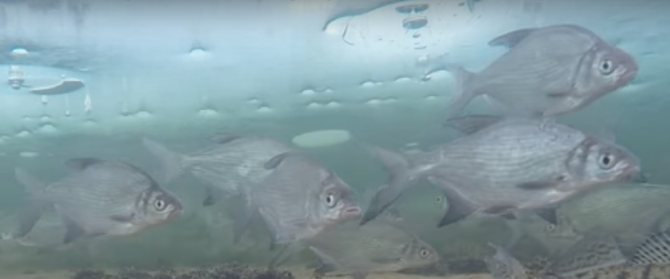
Where to look for bream on Akhtuba? In winter, this white fish is concentrated in holes, which are often characterized by a reverse flow direction. Impressive bream trophies of record sizes can be found in areas with depths ranging from 4-9 meters. For fishing in these places, as a rule, heavier equipment and baits are chosen. It is recommended to fish in such areas at the exit from the pits. It should be remembered that during a thaw, bream leaves deep areas, so the fishing depth during this period does not exceed one or two meters. The best food for it is vegetation, which is lifted from the bottom by the breaking water.
When going ice fishing for bream, you should choose the right ice ax. After all, he is the main tool in this matter. In shallow water areas, a strong current promotes the freezing of a large number of particles of mineral rocks and pieces of stones into the ice shell. When drilling holes, the latter quickly dull the cutting element of the ice ax. The optimal diameter of the tool is 30 cm. It is not advisable to use 90–120 mm augers for bream fishing, since it is difficult to bring a large trophy (weighing 0.5 kg or more) into such a hole.
Fishing for bream in pits in winter, as a rule, is not complete without the use of a variety of bait mixtures. The food is delivered to the bottom using special feeders.
During the current (and on Akhtuba it is especially strong), complementary foods are quickly washed away. When fishing on streamers, it is not advisable to use fertilizer.
Winter gear for catching bream in the current
To catch bream on the current in winter, use such gear as a float rod, a descender, a rocker, and a winter feeder.
Winter float rod
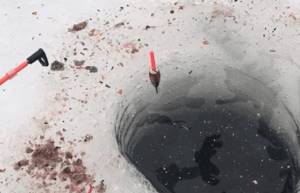
The float tackle used in the current differs from that used in still water. It has a number of features:
- Larger 2-3 piece bream float;
- Thick fishing line up to 0.2 - 0.22 mm cross-section;
- A heavy load in the form of an olive weighing up to 10 g;
- Long (up to 0.5 m) leash.
In addition to the float, such tackle is often equipped with a rigid and long guard made of a flat metal spring.
Descent (harvester, locomotive)
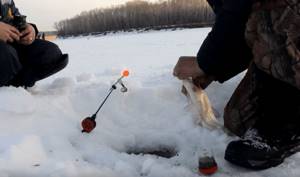
Homemade fishing gear for river fishing for bream is assembled as follows:
- A 20-30-meter supply of main fishing line with a cross-section of 0.28-0.3 mm is wound onto a 50-mm reel of a winter fishing rod with a handle;
- The line is passed through a twisted spring nod with a spherical bite indicator at the end, attached to the top of the whip. The length of such a gatehouse must be at least 15 cm.
- A swivel with a fastener is put on the fishing line;
- With the help of 2-3 silicone stoppers attached to the main fishing line, the swivel with a clasp restricts movement along it;
- A 10-15 cm leash with a homemade small feeder or a sinker weighing 30-40 g is fastened to the fastener;
- On a section of the main line located behind the stoppers, 3-5 leashes, each 20-30 cm long, are tied in increments of 50-70 cm. A large oblong-shaped jig (Uralka, Kaplya) weighing over 0.6 g is tied to the end of each leash;
- A small spherical sinker or a large carp jig weighing over 2 g is tied to the end of the main line.
We recommend reading: Black Sea scorpionfish ruffe
Rocker

A rocker is an effective tackle for catching bream in winter on a river with a current. It consists of the following parts:
- A solid lever (frame) with 2 arms, which is a piece of steel wire with a length of 109-12 cm of wire;
- Hanging ring in the middle of the frame;
- Two rings for leashes at the ends of the frame;
- Two short leashes 3-4 cm long;
- Loads weighing from 2 to 20–25 g.
Such equipment is tied to the main fishing line with a cross-section of 0.16-0.18 mm. A 2-piece bream float acts as a signaling device for this kind of fishing.
Helicopter

This bottom tackle consists of the following parts:
- A 15-meter working section of the main fishing line has a reel attached at one end and a swivel at the other. In the middle of the working segment, 3-4 hooks No. 10-12 are tied every 20-30 cm;
- Main line with a 30-40 gram pyramidal sinker;
- A fishing rod with a rigid nod made of a twisted or flat metal spring.
The helicopter is assembled as follows: hooks are tied to a piece of working line using a loop-to-loop knot, and a reel and a single swivel are attached to its ends. Next, the main fishing line is passed into the free eye of the swivel and a sinker is tied to its end. A lightweight aluminum profile is used as a reel for this gear.
Winter feeder
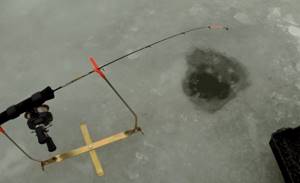
You can catch bream in winter with constant feeding using equipment such as a winter feeder. The main components of this analogue of a summer feeder are:
- Short carbon rod 50-70 cm long with 0.5 oz (about 14.5 g) dough
- Inertia-free coil size 1500-2000;
- Main line with a cross section of 0.18-0.2 mm;
- A feeder weighing no more than 20 g or a small sinker;
- A leash 0.5-1.0 m long made of fishing line with hook No. 12-14 at the end.
When fishing in winter, two summer feeder rigs are used: the Paternoster and the Gardner Loop.
Bait on the current
For winter bream fishing on rivers, feeder and universal bream bait mixtures are used. The main requirements for such bait are:
- Dark color - a dark feeding spot does not scare away large and cautious bream, nor does it attract small fish;
- Viscosity – a heavy and highly viscous mixture is well retained at the bottom and is less actively washed away by the current;
- Low content of aromas - in cold water, odors spread weakly, forming an area with a high concentration near the feeding spot, which repels fish.
We recommend reading: Catching perch in the spring with a spinning rod
When using both homemade and store-bought mixtures, it is mandatory to add bloodworms or maggots (100-150 g/kg of mixture).
How to attract
Fishing for bream will not be successful if you feed it incorrectly. According to the recommendations of experienced bream fishermen, bait should be as satisfying and simple as possible. Therefore, when fishing from ice, you shouldn’t get carried away with store-bought mixtures.
Prepare any cereal porridge:
- wheat;
- millet;
- oatmeal;
- cells;
- crushed corn;
- mixtures of cereals.
Add animal components to cooked or steamed cereals:
- bloodworm,
- maggot,
- mormysha.
This will be the best bait.
Attention! You can flavor the bait, but in very minimal doses, it is very easy to scare away wary bream with a pungent odor.
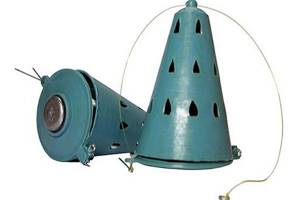
Conical dump truck feeders are best suited for feeding at great depths.
Fishing with pasta
One of the popular baits recently has become regular pasta. The fact is that during cooking they swell, which is why the fines are cut off. Only seasoned bream are suitable for this treat.
Here is an example of a video report about such fishing:
